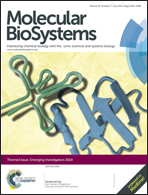Dynamics matter: differences and similarities between alternatively designed mechanisms†
Abstract
Cells selectively respond to external stimuli to maintain cellular homeostasis by making use of different regulatory mechanisms. We studied two classes of signal-dependent regulatory inhibition and activation mechanisms in this study. Inhibition mechanisms assume that inhibition can occur in two different ways: either by increasing the degradation rate or decreasing the production rate. Similarly, it is assumed that signal-triggered activation can occur either through increasing production rate or decreasing degradation rate. We devised mathematical models (deterministic and stochastic) to compare and contrast responses of these activation and inhibition mechanisms to a time dependent discrete signal. Our simulation results show that the signal-dependent increased degradation mechanism is a more effective, noisier and quicker way to inhibit the protein abundance compared to the signal-dependent decreased activation mechanism. On the other hand, the signal-dependent increased production mechanism can produce a much stronger and faster response than the signal-dependent decreased degradation mechanism. However, our simulations predict that both of the activation mechanisms have roughly similar noise structures. Our analysis exemplifies the importance of mathematical modeling in the analysis of biological regulatory networks.


 Please wait while we load your content...
Please wait while we load your content...